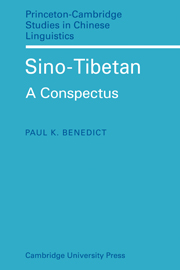Book contents
- Frontmatter
- Foreword
- Contents
- Preface
- Abbreviations
- 1 Introduction
- 2 Taxonomy (general)
- 3 Taxonomy (Sino-Tibetan)
- 4 Tibeto-Burman classification
- 5 Tibeto-Burman reconstruction (history)
- 6 Tibeto-Burman primary sources
- 7 Tibeto-Burman consonants (general; final)
- 8 Tibeto-Burman consonants (initial)
- 9 Tibeto-Burman consonant clusters
- 10 Tibeto-Burman vowels (finals; diphthongs)
- 11 Tibeto-Burman vowels (medials)
- 12 Tibeto-Burman tones
- 13 Tibeto-Burman morphology (history)
- 14 Tibeto-Burman morphology (categories)
- 15 Tibeto-Burman pronouns
- 16 Tibeto-Burman numerals
- 17 Tibeto-Burman morphology and syntax (general)
- 18 Tibeto-Burman affixes (special)
- 19 Tibeto-Burman affixes (general)
- 20 Tibeto-Burman dental suffixes
- 21 Tibeto-Burman prefixes (general)
- 22 Tibeto-Burman prefixed *s-
- 23 Tibeto-Burman prefixed *r-
- 24 Tibeto-Burman prefixed *b-
- 25 Tibeto-Burman prefixed *g-
- 26 Tibeto-Burman prefixed *d-
- 27 Tibeto-Burman prefixed *m-
- 28 Tibeto-Burman prefixed *a-
- 29 Tibeto-Burman alternation (consonantal, vocalic)
- 30 Karen (general)
- 31 Karen morphology (categories) and syntax
- 32 Karen pronouns
- 33 Karen numerals
- 34 Karen prefixes
- 35 Karen initial consonants and clusters
- 36 Karen final consonants and medial vowels
- 37 Karen final vowels and semi-vowels
- 38 Karen tones
- 39 Chinese (general, history)
- 40 Chinese morphology (prefixes, suffixes, alternation)
- 41 Chinese pronouns
- 42 Chinese numerals
- 43 Chinese phonology (history)
- 44 Chinese consonants (initials, finals)
- 45 Chinese consonant clusters
- 46 Chinese vowels and diphthongs
- 47 Chinese tones
- 48 Résumé (Chinese)
- Appendix I Tibeto-Burman roots
- Appendix II English–TB index
- Appendix III Primary Tibeto-Burman sources
- Appendix IV Author's and editor's bibliography
48 - Résumé (Chinese)
Published online by Cambridge University Press: 10 November 2010
- Frontmatter
- Foreword
- Contents
- Preface
- Abbreviations
- 1 Introduction
- 2 Taxonomy (general)
- 3 Taxonomy (Sino-Tibetan)
- 4 Tibeto-Burman classification
- 5 Tibeto-Burman reconstruction (history)
- 6 Tibeto-Burman primary sources
- 7 Tibeto-Burman consonants (general; final)
- 8 Tibeto-Burman consonants (initial)
- 9 Tibeto-Burman consonant clusters
- 10 Tibeto-Burman vowels (finals; diphthongs)
- 11 Tibeto-Burman vowels (medials)
- 12 Tibeto-Burman tones
- 13 Tibeto-Burman morphology (history)
- 14 Tibeto-Burman morphology (categories)
- 15 Tibeto-Burman pronouns
- 16 Tibeto-Burman numerals
- 17 Tibeto-Burman morphology and syntax (general)
- 18 Tibeto-Burman affixes (special)
- 19 Tibeto-Burman affixes (general)
- 20 Tibeto-Burman dental suffixes
- 21 Tibeto-Burman prefixes (general)
- 22 Tibeto-Burman prefixed *s-
- 23 Tibeto-Burman prefixed *r-
- 24 Tibeto-Burman prefixed *b-
- 25 Tibeto-Burman prefixed *g-
- 26 Tibeto-Burman prefixed *d-
- 27 Tibeto-Burman prefixed *m-
- 28 Tibeto-Burman prefixed *a-
- 29 Tibeto-Burman alternation (consonantal, vocalic)
- 30 Karen (general)
- 31 Karen morphology (categories) and syntax
- 32 Karen pronouns
- 33 Karen numerals
- 34 Karen prefixes
- 35 Karen initial consonants and clusters
- 36 Karen final consonants and medial vowels
- 37 Karen final vowels and semi-vowels
- 38 Karen tones
- 39 Chinese (general, history)
- 40 Chinese morphology (prefixes, suffixes, alternation)
- 41 Chinese pronouns
- 42 Chinese numerals
- 43 Chinese phonology (history)
- 44 Chinese consonants (initials, finals)
- 45 Chinese consonant clusters
- 46 Chinese vowels and diphthongs
- 47 Chinese tones
- 48 Résumé (Chinese)
- Appendix I Tibeto-Burman roots
- Appendix II English–TB index
- Appendix III Primary Tibeto-Burman sources
- Appendix IV Author's and editor's bibliography
Summary
In conclusion, the following points in re Chinese and Tibeto-Burman (or Tibeto-Karen) should be resumed: (a) Chinese shows almost no trace of the fairly elaborate TB morphology, (b) the two stocks have only a small segment of roots in common, (c) the phonological systems of the two stocks differ in many respects, and can scarcely be reconciled at all at some points, (d) the tonal systems of the two stocks appear not to be correlated. Our belief that the two stocks are genetically related must rest, ultimately, on the fact that they have certain basic roots in common, and that phonological generalizations can be established for these roots. It might be argued that the ST elements constitute only a superstratum in Chinese, and that the substratum is of distinct origin. In historical terms, the Chou people might be regarded as the bearers of a ST language, which became fused with, or perhaps immersed in, a non-ST language spoken by the Shang people. In any event, it is certain that the ST hypothesis illuminates only one of the many dark recesses in the complex linguistic history of the Chinese.
- Type
- Chapter
- Information
- Sino-TibetanA Conspectus, pp. 195 - 198Publisher: Cambridge University PressPrint publication year: 1972



